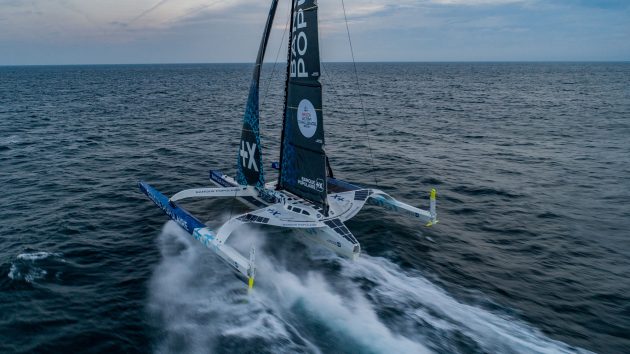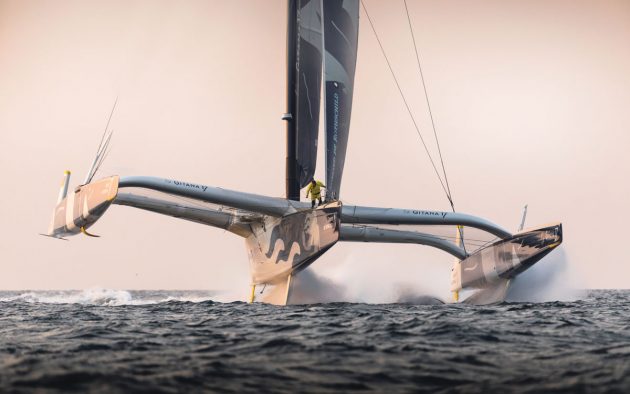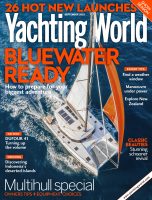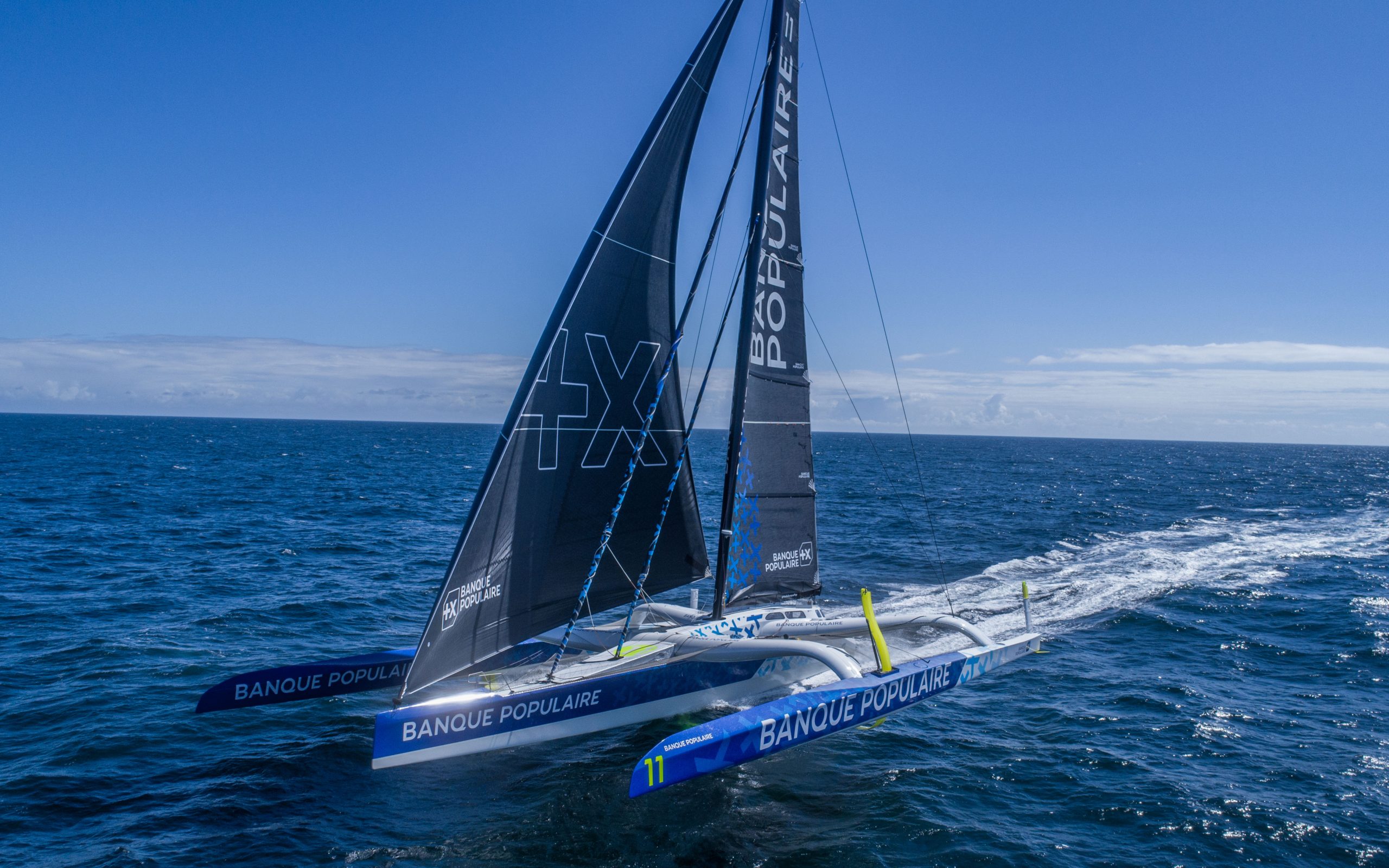The battle to be the first boat home will be hard fought between two giant trimarans in this years Fastnet Race, with the foilers promising an epic battle
As with most big races around the world, bragging rights in the Rolex Fastnet Race race are split into two broad camps, the line honours winners (the first boat to complete the course) and the winner of the event on corrected time.
And since the inclusion of multihulls 20 years ago, these categories are split again into monohull and multihull line honours and handicap winners.
Most of those taking part in the race, in either monohulls or multihulls, will only be focussed on the handicap results as a line honours win is out of reach of all but the fastest, biggest and most expensive boats in the world.
For the Rolex Fastnet Race 2023, the fastest boat to complete the course will almost certainly be one of the two 100ft foiling trimarans, the Ultim of Banque Populaire XI and SVR-Lazartigue.

Banque Populaire XI in full flight. Photo: Jeremie Lecaudey
Fastest Fastnet Race Multihulls
The foiling ocean racers are at the very forefront of technical innovation and are designed to break records – be that offshore races, ocean crossings or the ultimate prize a Jules Verne Round the World record.
The Ultim trimarans are set to become especially newsworthy over the next months with the first ever race for five of these extreme 32m long by 23m wide flying trimarans, around the world, non-stop, singlehanded, setting sail from Brest, France on 7 January next year.
Before then two of the main contenders will be leading the charge on the rather shorter 695 mile Rolex Fastnet Race.
Article continues below…
Extraordinary boats: Banque Populaire XI
Banque Populaire is one of the world’s most experienced and successful sailing teams, and was the force behind Armel Le…
The ultimate foiling machine? Onboard SVR-Lazartigue
Launched in July after 150,000 hours of work, SVR-Lazartigue is the latest addition to the burgeoning Ultim 32/23 fleet. In…
How to win the Rolex Fastnet Race: expert navigator’s tips
The 2021 edition of the Rolex Fastnet Race came with an interesting change. The finish line, having always previously been…
SVR-Lazartigue and Banque Populaire XI are skippered by two titans of offshore racing, Francois Gabart and Armel le Cleac’h respectively. Both are Vendée Globe winners (Gabart 2012, le Cleac’h 2016). Le Cleac’h is part of the exclusive club of triple winners of La Solitaire du Figaro (the unofficial world championship of solo offshore racing). He has been racing Ultims since 2013, this being his second boat.
Similarly, Gabart joined the Ultim class in 2015 winning many events with his MACIF trimaran, culminating in his record for sailing singlehanded non-stop around the world of just 42d 16h 40m 35s, incredibly just under two days shy of the fully crewed record.
Gabart has competed in the Rolex Fastnet Race twice before, winning on his IMOCA 60 MACIF in 2013 and then, in 2019, leading into the Plymouth finish line aboard his Ultim trimaran, only to be pipped at the post by Groupe Edmond de Rothschild, finishing less than one minute astern. “That was a little disappointing,” Gabart admits.

Charles Caudrelier and Franck Cammas on Maxi Edmond de Rothschild win the last Fastnet Race in 2021. Photo: Eloi Stichelbaut / PolaRYSE / Gitana
Neither of these Ultims competed in the 2021 race, when Charles Caudrelier and Franck Cammas on Maxi Edmond de Rothschild established the record for the new course to Cherbourg of 1d 9h 14m 54s.
Their Ultims are more than capable of bettering this and it’s possible a good breeze could even see the 14-year-old outright record for the most miles covered in 24 hours (908.2 miles/average speed 37.84 knots), also broken, given enough runway with suitable conditions and the will. If pressed, the latest Ultims could cover 1000 miles in a day (average speed 41.6 knots).
The top speed on Banque Populaire XI to date is 47 knots, but it is not top speed but high average speeds that Le Cleac’h says is the objective. “40-42 knots for one or two hours is very good, or 35-37 knots for 24 hours. We know that it is possible with our boat if the conditions are good.”
The performance of the Ultims has taken a massive leap in recent years, since new foil configurations have enabled them to fly.
For Banque Populaire XI getting airborne requires 12-13 knots of wind/22-23 knots of boat speed. Ideal conditions are no more than 20 knots as above this the sea state becomes too rough to use the foils effectively. Upwind in 15-17 knots Banque Populaire XI flies and will be making 27-30 knots. “That is the big step forward compared to the last Ultims, and that difference is very important compared to the older generation Ultims.”
“We regularly reach speeds of over 40 knots at less than 90° true wind angle (TWA),” says Gabbart. “In certain conditions, such as 25 knots of wind on flat seas, at 65°-70° off the wind, you’re doing 40 knots. That’s 60-65 knots of apparent wind speed. The maximum AWS in our log is not far from 70 knots.”
Of course one of these two foiling beasts being first to finish the Fastnet Race does require that they actually finish. The giant trimarans are at the very forefront of innovation and are famously susceptible to damage.
Reliability is improving, however, as foiling technology improves but even these hugely developed technological marvels the old adage holds true; ‘to finish first, first you have to finish’.
 If you enjoyed this….
If you enjoyed this….
Yachting World is the world’s leading magazine for bluewater cruisers and offshore sailors. Every month we have inspirational adventures and practical features to help you realise your sailing dreams.Build your knowledge with a subscription delivered to your door. See our latest offers and save at least 30% off the cover price.








